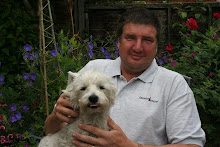 |
A bit swampy round the gate in the East
Field but at least the sheep can stand in
the dry to eat the rescue hay. Many sheep
keepers are suffering way worse. |
I'm not sure how you, at the reading end of this blog, are doing for weather, but here in Ireland, our appetite for this rain and wet is waning fast. I was off collecting straw today for a beef farmer friend who asked me last time to just get half a dozen because he was sure he'd have his animals back out onto the grass "soon" and he'd not need the full load of 15 bales in my small trailer. Now he is more "they'll not be out to May Day at the soonest now". Another guy at the straw dealer was bemoaning that we'd need a good 2 weeks to dry it out even if it stopped raining today.
 |
At least the sheep can have dry(ish) feet while they eat their
hay. I have spread a lot of gravel into this bit to stop the ground
chopping up so much in winter. |
As a whole, Ireland is looking down the barrel of another Fodder Crisis like the one in our first year here (2011) as saved hay and straw start to run out. For luck, I slung a couple of hay bales onto my load - there is precious little grass yet in my sheep field. There is a little movement but the sheep are very pleased to get their crunch and hay each day so they can at least have that full belly feeling.
 |
It's not all rain. I managed to get this complete line of post-visit
table linen through the system. |
Which brings me to a related matter - weaning the bottle fed lamb. Little Bábóg is three weeks old now and starting to look very burly. We noticed that all the other lambs have started sneaking their noses in between the adult sheep to snatch a bit of the 'crunch' (like muesli with molasses) or the hay that we are feeding to the ewes. They are weaning themselves off the milk as Mum's milk starts to peak-flow and their ruminant guts start to work as proper grass-fermenting chambers. I have even seen Polly's two lambs (5 weeks) sitting in the shelter cudding.
 |
| Our flowering cherry, just starting. |
It was back to the books then, for us, and the label on the 'Lamlac' packaging, plus a discussion topic opened up on Twitter to see how you go about this on bottle fed lambs. The consensus seems to be to wait till Day 35 at least and then, if you think (or know) that your lamb is taking at least 250g of solid food per day, you just do a "hard wean" taking the bottle away in one go. No messing about with watered down milk or small measures; the lamb's gut cannot happily do both food types at once unless they are coming little and often.
 |
| You are being watched. The ever-hopeful pigs keep an eye. |
Readers may know that the sheep liver fluke is a complicated parasite which spends only part of its life cycle inside the sheep, chewing away at its liver and creating a good range of 'unwell' symptoms. The rest of the life cycle is spent in a mud-snail which loves the wet Irish bog-land soil. In normal years it seems to stay away from our, higher ground and we get no fluke problems in our sheep. Every time we send a lamb to slaughter, we get the butchers to slice through the livers and check for any damage. They are always 'clean'.
 |
| Silvergirl's thriving and surviving 5 chicks, 3 weeks old here. |
This year though, you will know, that one of (ewe) Rosie's post-natal problems was early stage fluke damage. Vet, Aoife, told us that it is such a bad year that pretty much "everyone" has the problem. I can imagine. I look out across those sheep foot-print sized puddles in our field and I can just see the little flukey snail bas***ds thriving and doing a population explosion across the acre.
 |
Sporting their new ear tags. Three of the lambs with one of
the mums. |
We got all the flock into the cattle-race on a rare dry day yesterday, fluke-drenched all the ewes and took the opportunity to ear-tag all the lambs. The drench is 5.25 ml of chalky bluish gloop given by mouth using a syringe (with no needle obviously). Legal and healthy all on the same day. There's shepherding!
Meanwhile a minor miracle happened in the never-ending fox saga. The hens won a point back for their score board. The Guinea fowl alarm went up at 11 a.m. and we jumped to, and let the dogs out. They shot off with their "it was a fox" focus and speed. When there is no fox they amble about looking for a scent-trail and soon lose interest and return. We declare it a false alarm and move on. While they were gone on this one, I was able to walk round the far side of the poly-tunnel and spotted the sad slew of grey feathers. I was sure the fox had nabbed a hen.
 |
| Young love? The turkeys displaying to one another. |
Ten minutes later and still no dogs, so I walked down to by the bee hive to look for distant white shapes meandering back to me between the rushes (that field, which is not ours, is more rush than grass!) and was amazed to see a grey hen walking back towards me from 50 yards out. She was very much alive, chuntering in an upset kind of voice and looking a bit shaken and ruffled. I can only think that the dogs caught up with the fox for some reason and the fox was forced to drop the hen in his flight. The hen rejoined the main rooster (Gandalf). What he said to her is not on record, but they spent the rest of the day as if nothing had happened. Go the grey hen.
 |
| Turkey egg. |
Of course, you will know that the main story at the moment is nothing to do with rain, weaning lambs or the fox's antics. It is THE PLAY. You'll be pleased to know that the Lisacul Players nailed it on their first night, delighting a capacity crowd with a superb, very funny, enjoyable performance. Everyone is relieved and delighted. There are now two more performances, tonight and on Saturday, so I will give you a more thorough account in the next post, when it is all over and debut Producer (The Lady of This House) has had a chance to recover. If you are going then do as the printed programme says and "sit back and enjoy the mayhem". It is great.











No comments:
Post a Comment